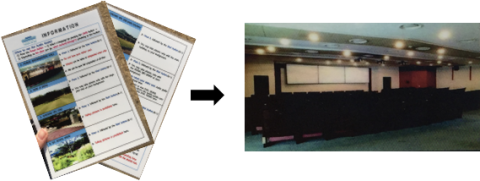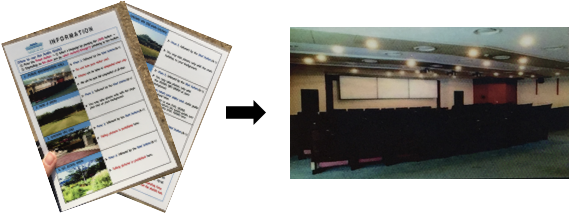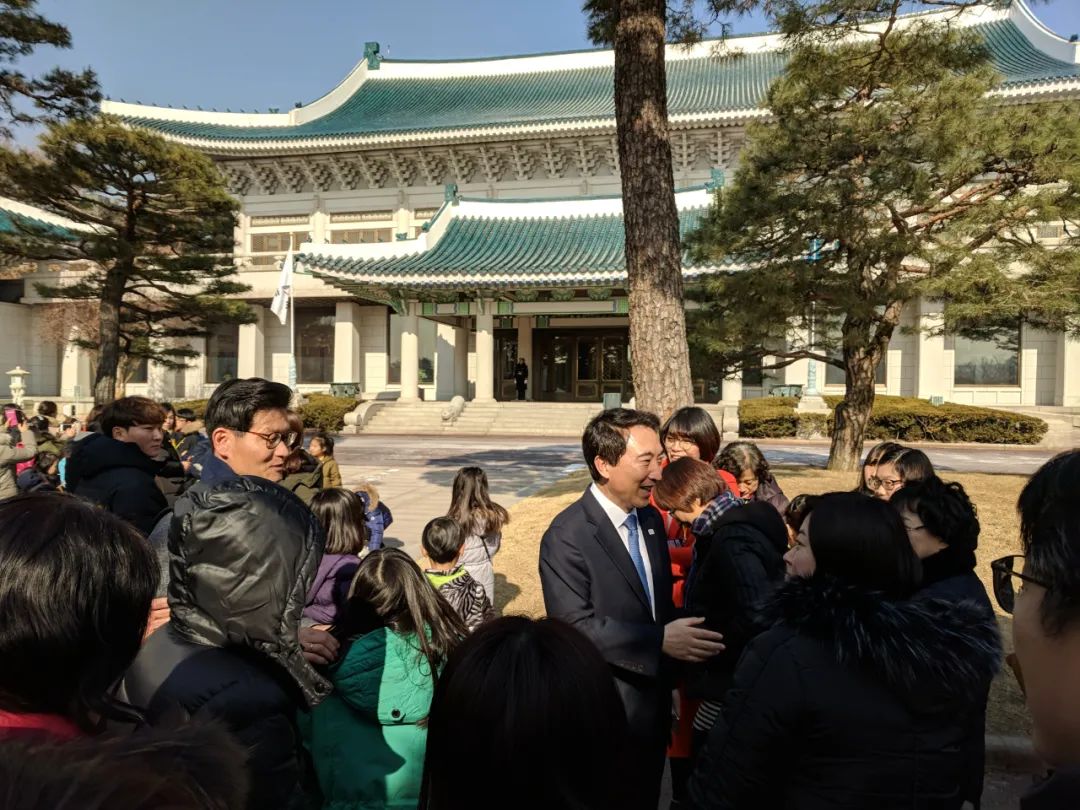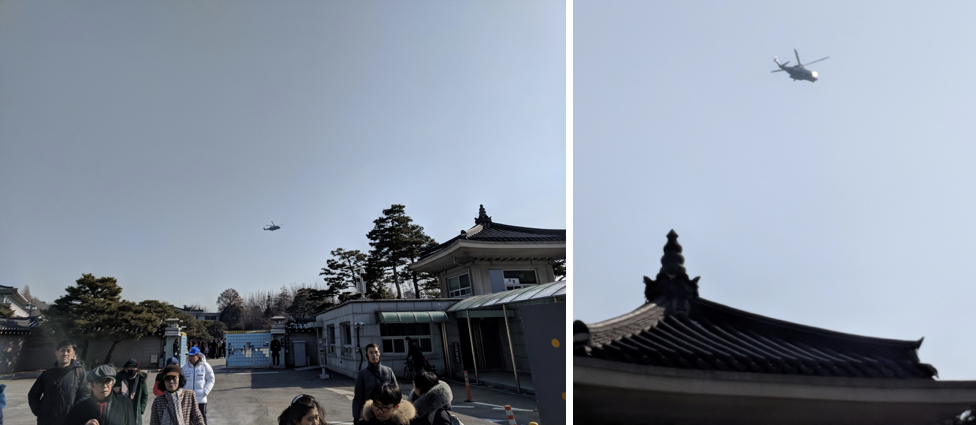
After wandering around Gyeongbokgung Palace in the morning, watching the changing of the guard ceremony, and experiencing the uniforms of the guards, we suddenly showed up at the registration office for the Cheong Wa Dae trip - Cheong Wa Dae Taipei is South Korea The Presidential Palace is open to the public free of charge, and only needs to make a reservation in advance. I made an appointment for the trip at 11am today.
The registration office for the Cheong Wa Dae tour is next to the parking lot of Gyeongbokgung Palace, about 100 meters away from Hypseongmun Gate. After showing your reservation number and passport at the registration desk, the guard present motioned me to get on a bus next to me. This bus was full of Koreans, chatting loudly. There were two children resting on the seat. The seat back was adjusted to 150 degrees. There was no room for anyone in the back row, and their parents were sitting next to them chatting with no intention of stopping them. Big Bear and I had to sit further back.
The bus quickly filled up. Finally, a young mother came up with her daughter. When she found that there was no other place to sit, she yelled at the two children in Korean. The two children straightened their chair backs obediently.
It seems that naughty children and naughty parents do not respect national boundaries.
After the bus started, the guard on board began to tell everyone the precautions in Korean. Daxiong and I looked at each other, and he asked me quietly: "You are not signing up for the Korean language group, are you?"
Me: "Have some confidence in me. I signed up for the English group."
We drove into the Blue House in less than ten minutes, and there were heavy guards along the way. Since I didn't understand the precautions just mentioned, I wasn't sure if I could take pictures here. For safety reasons, I decided not to take pictures.
After we got off the bus, we asked the guard if there was anything we needed to pay attention to. The guard obviously didn't speak English well and kept smiling awkwardly. He pointed at a door and said, "This way, please." After entering, you need to go through the security check and each person will be given a handout. There is a guide available in multiple languages including Chinese, English, and Korean.

Next to the security check is the Information Hall, which is the first stop of Cheong Wa Dae. Unfortunately, all the explanations are in Korean. Fortunately, I did enough research and knew the history of Cheong Wa Dae without any explanation.
The Blue House is just north of Gyeongbokgung Palace, just one street away from Gyeongbokgung Palace. Its former site was once the backyard of Gyeongbokgung Palace. Later, after Korea was occupied by Japan, the Korean Governor-General Nanjiro built a hall at the current location and turned it into the official residence of the Korean Governor-General. After Japan surrendered in 1945, it became the official residence of U.S. Army Lieutenant General John Hodge. It was not until the founding of the Republic of Korea in 1948 that it was converted into the presidential palace. During the Korean War, a fire broke out here and the Presidential Room was burned down. The main Blue House building you see now was rebuilt in 1991 during the reign of President Roh Tae-woo.
When we left, each of us was given a small souvenir - a mug with the Cheong Wa Dae logo printed on it.
After leaving the information hall and going up the stairs, there is a green space. Is this the legendary Green Land Garden? This is too small! I dubiously selected "2: Green Garden" in the guide. According to reports, there is also a century-old pine here. I looked around and saw pine trees, but they looked like they were no more than ten years old. No matter, let’s take pictures first. So Big Bear and I took a photo with an unknown small tree on this small lawn. By the way, I despised the Koreans in my heart for even listing this place as a tourist attraction.
There was a Korean group next to us, and everyone looked at us curiously as we took a group photo here.
After a turn and a descent, we understood the meaning of our gaze. It turned out that after the turn was the real green garden, which was not much larger than the grassland just now.

However, the garden is no longer big, and there are immortals and spirits. There is a century-old pine in the Greenland Garden, which is the one that is added up with a bracket in the picture above. There is also a building called "Changchun Zhai" behind the pine trees. The tour guide present introduced it in Korean for about 15 minutes, but the guide only had about 5 minutes of introduction, so Big Bear and I started taking selfies out of boredom.
After that, we left from Yongchung Bridge on the side of Cheong Wa Dae. The small pool under the bridge was completely frozen. Once again, I regretted: Why did I come to Korea in winter? ? ?

After crossing Yongchung Bridge, we walked uphill for a while and saw the main building of Cheong Wa Dae in front of us. The tour guide took us around to the wooden platform on the side of the main building of Cheong Wa Dae. Jimutai is actually a small forest. The fourth attraction So Jeong Won is part of Jimutai, but because it is not introduced in the guide, I don’t know what his Chinese name is. I only know that he is a star. Very rare redwood.

But the woods and the redwoods are not the point. The key point is that a very important treasure was unearthed here - the stone tablet of "The Best Blessed Place in the World".
It turns out that President Roh Tae-woo started to build the current Blue House when he was in office. As a result, a stone tablet was dug up at this place. On the stone tablet were engraved the six Chinese characters of "The Best Blessed Place in the World". It is said that this was left during the reign of the Joseon Dynasty (1392-1897). The original object was regarded as a Feng Shui treasure and was well preserved. What you see now is just a proportional stone tablet. And considering that Koreans today cannot read Chinese characters, the government thoughtfully placed another stone with Korean characters next to it, which attracted happy Korean people to take photos.

Pretending to dig out stone monuments to announce God's will is nothing new to us, so I have no interest in this attraction. It is completely different from the joy and excitement that Koreans feel when they see stone monuments.
And looking at the fate of successive presidents of South Korea, who would think that this place is a geomantic treasure? ? ?
The first president Syngman Rhee was finally forced to resign and fled to Hawaii, never returning to his country until his death.
The second president, Yun Bo-sun, was overthrown by Park Chung-hee's military coup after only nine months in office.
The third president, Park Chung-hee, the father of the previous president Park Geun-hye, was eventually assassinated.
The fourth president, Choi Kyu-ha, was overthrown by Chun Doo-hwan's military coup after only eight months in office.
The fifth president, Chun Doo-hwan, was sentenced to death, which was later commuted to life imprisonment. After receiving the presidential pardon, I thought I could retire with my property, but the South Korean Congress refused to give in. Finally, in 2013, it passed a special law on criminal confiscation of public servants called the "Chun Doo-hwan Expropriation Law", which embroiled Chun Doo-hwan in accordance with the law. s home.
The sixth president, Roh Tae-woo, probably saw the fate of the previous five presidents, so he quickly rebuilt the Blue House in an attempt to improve the feng shui. This change seemed to be quite effective - Roh Tae-woo was eventually convicted of participating in military rebellion and civil strife, and murder. He was sentenced to 22 years for attempted superiority and bribery, but was later pardoned by the president.
The seventh president, Kim Young-sam, was quite lucky. However, he encountered the Asian financial crisis and resigned amid criticism. He lived his old age peacefully. He did not die of complications from septicemia until he was 86 years old. However, his son was more unlucky and was imprisoned for taking bribes.
The eighth president, Kim Dae-jung, also died of illness at the age of 85. However, his three sons were all sentenced for accepting bribes. It must be said that this was the tragedy of the anti-corruption president in his later years.
The ninth President Roh Moo-hyun was scrutinized after leaving office, and finally chose to commit suicide by jumping off a cliff under pressure.
The tenth President Lee Myung-bak left office peacefully in 2013. It is said that the Moon Jae-in government's anti-corruption work is in full swing. Lee Myung-bak was originally going to be summoned a while ago, but later a new case emerged and the summons was postponed. Therefore, it is really hard to say what his later years will be like. Moreover, he himself is charged with driving Roh Moo-hyun to death and has a large number of political enemies. By the way, he was the one who renamed Seoul to Seoul.
Needless to say, the 11th Park Geun-hye, we almost witnessed the entire process of her resignation. Recently her sentence was handed down - 30 years in prison. Considering her age, she might not be able to get out of prison until she dies.
The twelfth President Moon Jae-in just took office last year. At the inauguration ceremony, he directly stated that he would find another place to live and would no longer live at the Blue House. This is a sensible person. It is said that Abe refused to move in because the Japanese prime minister's mansion was haunted, and as a result he became the longest-serving prime minister in recent years.
The feng shui of the Blue House really needs to be avoided. I wish President Moon good luck.
Seriously speaking, in a place like the Blue House, where even the garbage is dug through and leaked to the media (see the unlucky Park Geun-hye), it has probably been infiltrated into a sieve. It is expected that Moon Jae-in does not want to live there.
Looking at this stone tablet and thinking about the experiences of the generals of the past dynasties, I think Koreans may have some misunderstanding of the word "blessed land".


After walking around for a long time, we finally arrived at the highlight of today - the main building of Cheong Wa Dae. This is the center of the entire Cheong Wa Dae, where the President's Office, the Audience Room, the State Council Conference Room, etc. are all located.
It was built in 1991. It is said that a total of 150,000 blue tiles were laid on the roof. They were made using traditional Korean craftsmanship and have kept their color unchanged for hundreds of years. The buildings on both sides of the main building are named after our acquaintances - Yi Sunsin's Room on the left and Sejong's Room on the right.
PS: For the history of Yi Sunseong & Sejong, please see "Travel Notes in Korea·Gyeongbokgung Palace 1·Gwanghwamun Square"
As we gathered around the supervisor to listen to the introduction from the tour guide/narrator, a black car drove over and several guards surrounded us. I thought the guards were here to help clear the way, but I didn’t expect the people in the black car to greet us under the protection of the guards. People in our group began to get excited and went up to shake his hand one after another. Some people held his hand and talked nonchalantly, and some even had tears in their eyes with excitement.
Big Bear asked me in a low voice: "Is he the president of South Korea?"
I answered uncertainly: "Probably not. The current president should be much older than him."
Daxiong quickly learned the Korean word "안녕하십니까 (Hello)" and then blended into the crowd to shake his hand.
When it was my turn, I was excited and my mind was stuck. I held his hand and said in Chinese: "Hello."
The other person gave me an awkward yet polite smile, quickly took out his hand to shake hands with the person next to him and exchanged greetings in Korean.

After he left, I took out the candid photos and asked the guards nearby who he was. The guards’ English was not very good. After discussing it in Korean, I came up with a news word - Spokenman, which turned out to be a government news statement. people. After returning to the hotel, I searched and found that he was Park Soo-hyun, the Blue House spokesperson.

Looking at the Cheong Wa Dae from a close distance, I just feel that its colors are very beautiful, shining brightly in the sun. When I walked to a distance and looked again, I realized that his Feng Shui was really good. It was backed by Beiyue Mountain, which was a natural Feng Shui situation. It is said that after the site for the Forbidden City in Beijing was selected, since the entire North China Plain was flat and there were no mountains, they built one themselves, namely Jingshan Park to the north of the Forbidden City, where Emperor Chongzhen of the Ming Dynasty later hanged himself.
Not only does the Blue House have a backing to the north, it also has mountains on both sides - Inwangsan Mountain and Luoshan Mountain, thus forming a pattern of green dragon on the left and white tiger on the right. When South Korea's economy took off in the last century and the "Miracle on the Han River" was created, everyone said that the Feng Shui here was good.
However, bad luck has continued in South Korea in recent years, and the Korean people have begun to doubt the Feng Shui of Cheong Wa Dae. Therefore, the same place and the same furnishings have become an extremely bad Feng Shui situation under the description of the media. What kind of "sword pierces the heart" Professional terms such as "white tiger holding corpse" and "white tiger carrying corpses" have come out. Some people even said that this is the pattern of the mausoleum. There are even rumors that the Japanese colonization destroyed their dragon veins. In short, there are all kinds of news.
In fact, I would say that there should be less feudal superstition and more scientific outlook on development. Haven't you ever thought that you ended up in a miserable state because you were deceived by the United States and started to imitate other people's democracy before the foundation was laid?
What is even more tragic is that the South Korean president, who was born with deficiencies, met the more bloody Korean people and protested at every turn, accompanied by extreme measures such as finger severing, disembowelment, and self-immolation. The South Korean president was even more difficult to move forward.

Bukaksan Mountain behind Blue House was closed for a long time and climbing was not allowed. It was not opened until 2006, but you still need to apply before going up the mountain. It is said that this military blockade was because North Korea sent 31 personnel to South Korea to attack the Blue House in 1968. At that time, they climbed over Bukak Mountain and successfully approached the Blue House. Later, they were found in Cheongundong near the Blue House because of the black rubber shoes on their feet. After being discovered, the two sides started a shootout. After that, Beiyue Mountain was blocked by the military until 2006.
Daxiong and I planned to go hiking in Zhangjiajie after Korea, so we didn’t plan a climbing trip in Seoul. Otherwise, Beiyue Mountain is really a good place overlooking Seoul.
After taking a few photos, we left the Blue House.

The last stop is the guest house. This is a Western-style building built in 1978. During this period, President Park Chung-hee mostly received domestic and foreign dignitaries in the guest house of the Shilla Hotel. However, we found that the security work in the Shilla Hotel was more difficult, so we simply built one in the then Presidential Palace. Since then, state banquets and state guests have been held here.
This building has three doors. It is said that only the president can use the main door, and other national leaders must use the side door. After listening to the introduction of the guide, I was curious about where the President of the United States would go when he came? Is Trump willing to take a side door?
Another thing worth introducing about this building is its 12 columns, 4 in the front and 8 in the back. It is said that the front four are carved from a single piece of marble and are completely seamless.

When we left the State Guesthouse, we happened to see the presidential plane flying over the Blue House. It's a pity that I didn't get a chance to see the president.
As we were leaving we saw another identical plane. It turns out that presidential planes always appear in pairs, and even the people around the president don’t know which plane the president will be on today. This was done for security reasons. Even if someone wanted to assassinate him, he didn't know which plane to target.

I checked my current location by the way, and found out that the location of the Blue House was blank - for security reasons, they did not mark the Blue House on the map, and even the trip to the Blue House was from Gyeongbok. Depart from the palace parking lot.
Directly in front of the guest house is a busy street, with a side entrance next to it. We lined up in two teams at the side entrance. One team left directly by bus, while the other team could go to the Seventh Palace next to the Blue House. You are free to choose which team to go to.
We chose the group that went to the Seventh Palace, and then left the Blue House with the large group.
